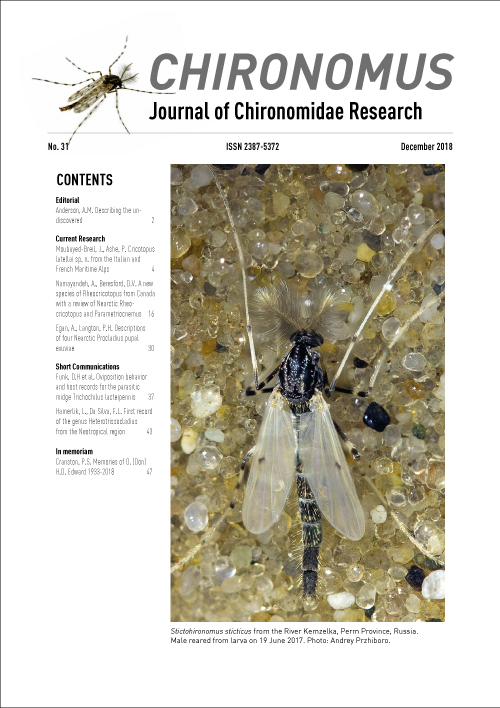A new species in the Rheocricotopus (R.) effusus group from Canada with a review of the Nearctic species of Rheocricotopus and Parametriocnemus (Chironomidae: Orthocladiinae)
Main Article Content
Abstract
Rheocricotopus (Rheocricotopus) reduncusoides sp. n. is described from Bathurst Island, Nunavut, Canada. Its discovery was made while curating and examining specimens deposited by H. V. Danks in 1969 at the Canadian National Collection in Ottawa, Canada. We also report the first Canadian record of Parametriocnemus hamatus (Johannsen, 1934) from Québec, based on previously unsorted material deposited at the Canadian National Collection. In this paper we provide distributional records of the Nearctic species of Rheocricotopus Thienemann and Harnisch and Parametriocnemus Goetghebuer, and present a key to the Nearctic adult males of these genera.
Downloads
Download data is not yet available.
Article Details
How to Cite
Namayandeh, A., & Beresford, D. V. (2018). A new species in the Rheocricotopus (R.) effusus group from Canada with a review of the Nearctic species of Rheocricotopus and Parametriocnemus (Chironomidae: Orthocladiinae). CHIRONOMUS Journal of Chironomidae Research, (31), 16-29. https://doi.org/10.5324/cjcr.v0i31.2531
Issue
Section
Current Research
Authors who publish with this Open Access journal agree to the following terms:
- Authors retain copyright and grant the journal right of first publication with the work simultaneously licensed under a Creative Commons Attribution License 4.0 that allows others to share the work with an acknowledgement of the work's authorship and initial publication in this journal.
- Authors are able to enter into separate, additional contractual arrangements for the non-exclusive distribution of the journal's published version of the work (e.g., post it to an institutional repository or publish it in a book), with an acknowledgement of its initial publication in this journal.
- Authors are permitted and encouraged to post their work online (e.g., in institutional repositories or on their website) prior to and during the submission process, as it can lead to productive exchanges, as well as earlier and greater citation of published work (See The Effect of Open Access).
